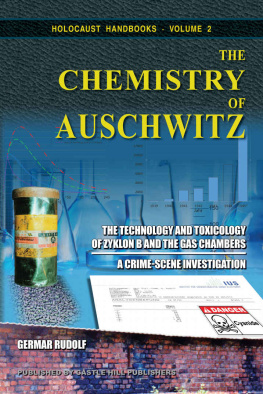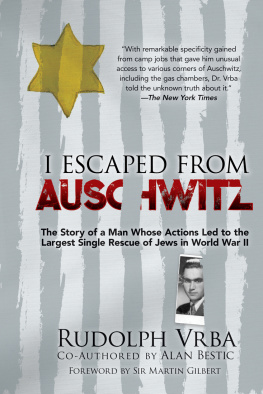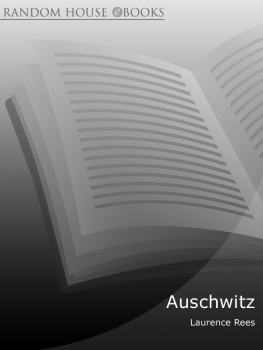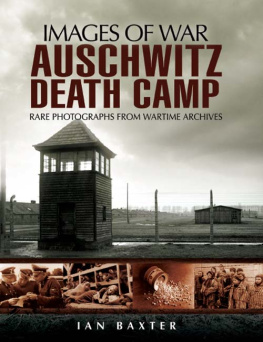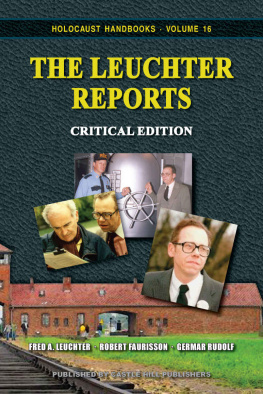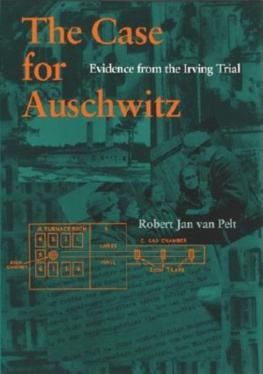Germar Rudolf - The Chemistry of Auschwitz: The Technology and Toxicology of Zyklon B and the Gas Chambers—A Crime-Scene Investigation
Here you can read online Germar Rudolf - The Chemistry of Auschwitz: The Technology and Toxicology of Zyklon B and the Gas Chambers—A Crime-Scene Investigation full text of the book (entire story) in english for free. Download pdf and epub, get meaning, cover and reviews about this ebook. year: 2017, publisher: Castle Hill Services, genre: Art. Description of the work, (preface) as well as reviews are available. Best literature library LitArk.com created for fans of good reading and offers a wide selection of genres:
Romance novel
Science fiction
Adventure
Detective
Science
History
Home and family
Prose
Art
Politics
Computer
Non-fiction
Religion
Business
Children
Humor
Choose a favorite category and find really read worthwhile books. Enjoy immersion in the world of imagination, feel the emotions of the characters or learn something new for yourself, make an fascinating discovery.
- Book:The Chemistry of Auschwitz: The Technology and Toxicology of Zyklon B and the Gas Chambers—A Crime-Scene Investigation
- Author:
- Publisher:Castle Hill Services
- Genre:
- Year:2017
- Rating:5 / 5
- Favourites:Add to favourites
- Your mark:
The Chemistry of Auschwitz: The Technology and Toxicology of Zyklon B and the Gas Chambers—A Crime-Scene Investigation: summary, description and annotation
We offer to read an annotation, description, summary or preface (depends on what the author of the book "The Chemistry of Auschwitz: The Technology and Toxicology of Zyklon B and the Gas Chambers—A Crime-Scene Investigation" wrote himself). If you haven't found the necessary information about the book — write in the comments, we will try to find it.
The gas chambers of Auschwitz have been called the epicenter of human suffering. More human beings are said to have died a violent death there than on any other place on earth in the history of mankind.
The biggest crime scene of history, in terms of its death toll, not only demands the utmost respect for its victims, but should also attract the most-intensive attention of forensic researchers to find out what exactly happened, and how. Or so one might think.
Forensic research on Auschwitz, however, has always been controversial. Investigating the gas chamber mass murder is considered a blasphemous act, a way of disturbing the peace of the dead.
While respecting the victims, whether of foul play or of circumstance, this study nonetheless tries to conduct Auschwitz research on the basis of the forensic sciences, where material traces of the crime and their interpretation reign supreme. Although it is generally agreed that no autopsy of any victim has ever been performed, most of the claimed crime scenes - the chemical slaughterhouses called gas chambers - are still accessible to forensic examination to a greater or lesser degree. So, how did these gas chambers of Auschwitz look like? How did they operate? What were they used for? In addition, the infamous Zyklon B can also be examined. What exactly hides behind this ominous name? How does it kill? And what effect has it on masonry? Does it leave traces that can be found still today?
These and many other questions are thoroughly examined in this study. The horror of Auschwitz is meticulously dissected, and thus, for the first time, it really becomes comprehensible.
Germar Rudolf: author's other books
Who wrote The Chemistry of Auschwitz: The Technology and Toxicology of Zyklon B and the Gas Chambers—A Crime-Scene Investigation? Find out the surname, the name of the author of the book and a list of all author's works by series.

